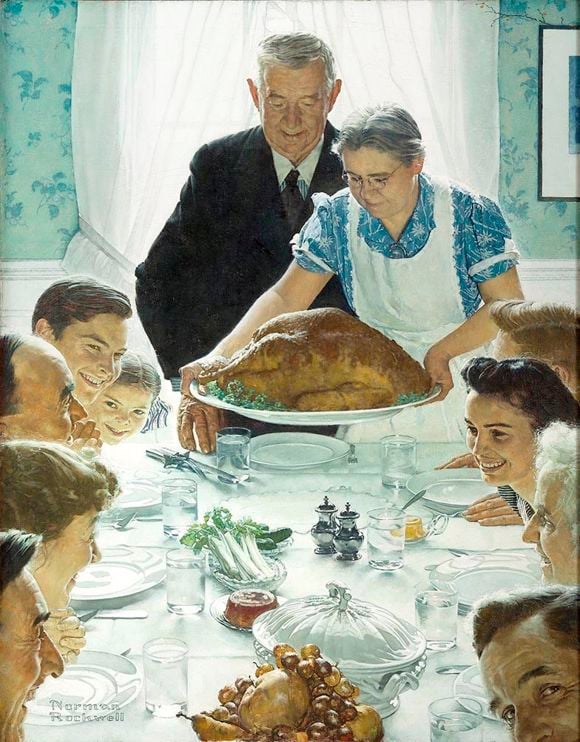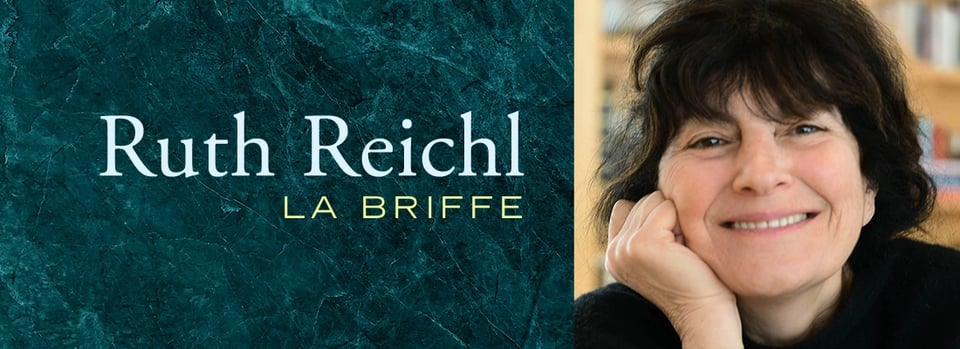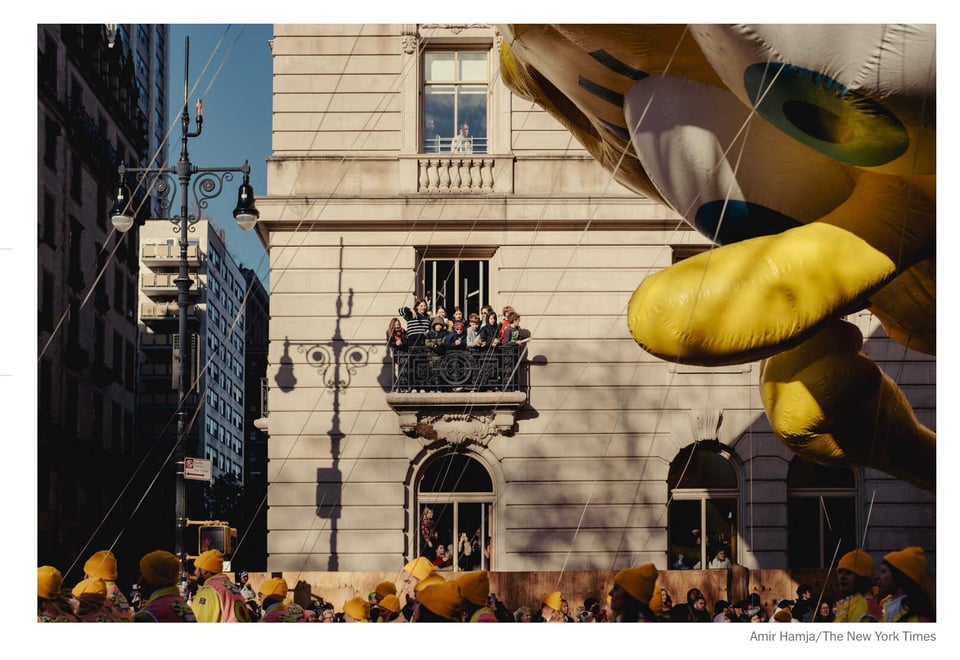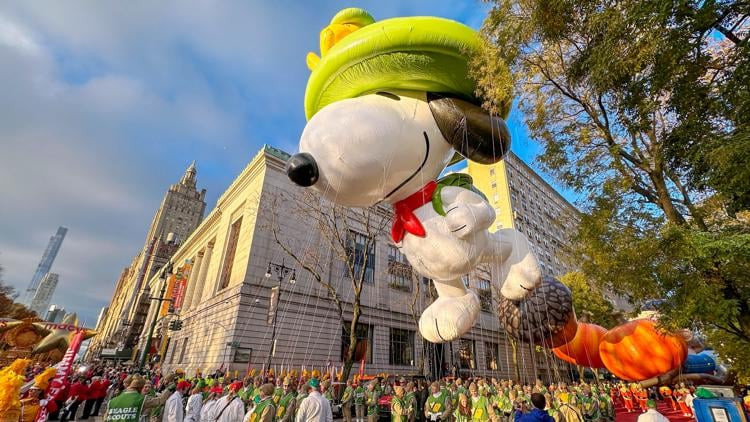Thursday, November 28, 2024. Annette’s News Roundup.
Thinking about Thanksgiving.

Norman Rockwell, Freedom from Want, 1943, oil on canvas, illustration for The Saturday Evening Post, March 6, 1943, collection of Norman Rockwell Museum. © SEPS: Curtis Licensing, Indianapolis. All rights reserved. www.curtislicensing.com.
Eric Kim, food and cooking columnist for The New York Times since 2021, on Turkey.
“How do you make something ordinarily boring and dry, for so many, taste suddenly juicy?”
Ruth Reichl on Thanksgiving.

Last year, as I was standing in the kitchen, there was Mom, standing beside me. “Your turkey’s going to be overcooked,” she lamented as I set the timer for four hours.
“Mom,” I said, “this bird weighs 24 pounds!”
She shook her head. My late mother had some extremely strange notions about cooking. Although no turkey on the planet will cook in under an hour in an ordinary oven, Mom refused to accept that. Let me just say that Mom’s turkeys were never dry.
“And what are you doing now?” she asked, peering over my shoulder. I was squeezing pomegranate juice. Nick, the grandson Mom never met, loves the sweet tart gravy I first made when he was six, and it’s been a staple on our table ever since. As I was silently explaining this to her, I was startled by a thought: this ritual meal is powerful not because we gather with our families, but because we gather with our ghosts.
My kitchen grew increasingly crowded; as I creamed onions Aunt Birdie suddenly appeared. “Do you remember,” she asked, “the first Thanksgiving you ever cooked?” How could I forget? She was 100 years old, and we had to carry her up the stairs of our lower east side loft. “I don’t remember that” she sniffed. “What I do remember is that we were all thrilled when you agreed to do it. And that you were very nervous.”
Well of course I was! When the meal moved from Mom’s house to mine, it seemed like a major rite of passage and the first time I truly felt like a grown up. I fussed about, desperate to get every detail perfect. It wasn’t: as I remember, the turkey was dry, the mashed potatoes lumpy. But that was also the day I learned the most important fact about Thanksgiving, one every cook needs to know. “We didn’t come to eat,” Aunt Birdie told me gently, “we came to be together and share a meal. We’re grateful when the food is wonderful, but it really doesn’t matter. Remember that.”
Aunt Birdie departed, but as I was scrubbing sweet potatoes a few friends from my Berkeley years came through the door. “Remember,” Jules said, “that time we decided we were vegetarian?” I certainly did. It was 1976, and what I remember most is that as I prepared vegetables for fifty I suddenly understood why so many holiday meals involve a giant piece of protein. Thanksgiving that year was an exhausting production, and by the time it was over our vegetarian days were too.
I roasted chestnuts, crushed cranberries, peeled potatoes; with each step some old friend was at my side. As I sharpened my knife the late Michel Richard, one of the finest chefs I’ve ever known, suddenly appeared. “So slow!,” he said, watching me carve the turkey in careful slices. That man could carve a bird in ten seconds flat: I timed him once. Each slice was perfect. That was in the early eighties, but I’ve yet to meet anyone who could beat him. And here he was, restored to me, poking gentle fun.
My ghosts stayed with me, flitting in and out of the kitchen as the day progressed. Even later, doing dishes, I was not alone. A few years ago, when all the guests had gone, I handed Laurie a dish to dry. My old friend held it for a moment and then blurted out, “The doctors say I’ve only got a few more months. This is my last Thanksgiving.” I miss Laurie — I always will — but last year she was with me at the sink, just like always, another visitor from Thanksgiving past.
This gives me great comfort. Years from now, when I’m long gone, I know that Nick will be standing in a kitchen carving turkey. Maybe he’ll be an old man by then, cooking for his grandchildren. But it’s nice to know that I’ll be there.
What Americans will be feasting on this Thanksgiving
By Steve Kornacki

It turns out there’s still something out there that can transcend the country’s deep political and cultural divides and bring Americans together: a big old Butterball.
A new Economist/YouGov poll finds that 67% of Americans who will celebrate Thanksgiving this week plan to have turkey on their plates. And, in a refreshing break from every single political poll during the presidential campaign, the crosstabs in this survey find nothing but consensus on this meal choice.
There’s no gender gap: 69% of men and 66% of women say they’ll be feasting on turkey.
Nor is there a racial gap: 69% of white and Hispanic Americans will have turkey, as will 68% of African Americans.
And there’s not even a meaningful partisan divide: 73% of Republicans and 67% of Democrats say turkey will be part of their meal.
Of course, Thanksgiving typically involves stuffing yourself silly with more than just turkey. And there are five other dishes that lesser majorities of Americans report they will also be noshing on.
Mashed potatoes: 56%
Bread or rolls: 55%
Pie: 54%
Gravy: 51%
Stuffing: 51%
Curiously, when it comes to these items, some small partisan fissures do begin to emerge. Sixty-five percent of Republicans will have mashed potatoes, while only 50% of Democrats plan to. And gravy will be served to 59% of Republicans and only 46% of Democrats. Why the tastes of partisans would diverge at all on these two foods is, alas, beyond our remit.
As for what’ll make up the rest of Americans’ Turkey Day menus, there’s plenty of variety, but no consensus:
Green beans: 40%
Sweet potatoes: 39%
Cranberry sauce: 38%
Corn: 33%
Macaroni and cheese: 27%
Ham: 26%
Brussel sprouts: 10%
And then there’s what may be the most puzzling group of Americans — the 2% who say they will be having Thanksgiving meals but wouldn’t include a single one of the foods listed above. Maybe the pollsters should have added turducken to the list? (Steve Kornacki, NBC News).
America’s Great Unifying Event: The Macy’s Thanksgiving Day Parade
The nostalgia-fueled production has been the most-watched entertainment program in the United States for the past three years, ahead of the Oscars and the World Series.

It might be the kookiest three and a half hours in all of television.
On Thursday, when the “Macy’s Thanksgiving Day Parade” returns to NBC, the broadcast will be fueled by, among others, nearly a dozen marching bands, the Rockettes, Al Roker, Snoopy, Cynthia Erivo, Cole Escola from the Broadway show “Oh, Mary!” and Santa Claus.
And yet, if history is any guide, the parade will draw more viewers than the Oscars, the Yankees-Dodgers World Series or the most popular New Year’s Eve telecast.
Though it has been an annual staple in American living rooms and kitchens since the 1950s, the parade became the most-watched entertainment show in the United States only over the past three years.
Other than some sporting events or marquee N.F.L. games — which can draw more than 30 million viewers — maintaining an audience, or even growing it, is a rarity in television these days. Award shows like the Oscars, Grammys and Emmys have had seesawing ratings in recent years that are well short of their heights from a decade or two ago.

The parade, on the other hand, has delivered virtually the same audience since the late 1980s — 20 million viewers each year, give or take. Last year, when viewership from an encore telecast and the Peacock streaming service was tallied up, the parade audience ballooned to over 28 million viewers, a new high.
“It totally defies gravity,” Jen Neal, NBC’s executive vice president of live events and specials, said in an interview.
Entertainment programs have struggled in recent years as more and more viewers abandon traditional television and migrate to streaming. Just last week, Comcast, NBCUniversal’s parent, announced it was spinning off much of its declining cable business into a separate company.
Comcast is, however, keeping the NBC broadcast network — in part because of live events like the parade.

The telecast has plenty going for it, television executives said. A totally captive audience, on a day millions of people stay home, certainly helps. So does its role kick-starting a holiday season when people are (generally) in a good mood. The element of a live production — Will it rain? Will it freeze? Will it be too windy for the balloons? — provides a jolt of unpredictability.
There also seems to be a deep well of nostalgia for a production that, more or less, looks roughly the same year after year: lots of floats, plenty of balloons, a dozen or so performances, the same opening act (the Tom Turkey float) and the same kicker (Santa).
“Those iconic moments have been part of our history and legacy since the earliest days,” said Will Coss, an executive producer of the parade. “We’re intentional about that. We care about that.”
Over more than three hours, each segment of the telecast rotates through five to 10 minutes of performances before heading into the next commercial break. The segments are “perfect for our social media-trained brains,” said Sarah Unger, a founder of Cultique, a consulting firm that advises companies on changing cultural norms.
“No segment is too long, and there’s spectacle in spades,” she said.
That is not an accident.

“The great thing about the parade is that there are so many elements, there’s something for every viewer,” said Bill Bracken, a producer of the telecast for more than 30 years. “It’s something we explain in our ‘coming up’ bumpers. Let people know, ‘Hey, maybe this wasn’t your favorite, but coming up next is this.’”
Nor is it afflicted with any political baggage. When award show ratings began cratering, some television executives blamed preachy political monologues and acceptance speeches for turning off swaths of Middle America. A viewer of the parade, on the other hand, could be forgiven for forgetting that presidential elections exist, or even what year it is.
“It kind of sits outside of time and culture — it’s like this stand-alone thing,” Ms. Unger said. “It’s separate from all the entertainment industry woes and the culture wars. It’s like going into an alternate universe.”
Producers of the show have long tried to appeal to a wide audience. Performances from Broadway shows are intended, in part, for families that “don’t have the opportunity to visit New York,” Ms. Neal, the NBC executive, said.
And the steady procession of high school and college marching bands from states like West Virginia, South Dakota, Arkansas and Texas also adds “that slice of America straight out of the heartland that we really, really want to make it a truly national event,” Savannah Guthrie, the “Today” anchor who hosts the telecast, once said in a retrospective about the parade.
(Mr. Bracken, the producer, said that, in the past, the telecast had gleefully highlighted when band members had taken a plane for the first time to participate in the parade.)
The ratings are evenly distributed across the country. Over the last two years, liberal enclaves like New York, Baltimore and New Haven are among the highest rated local markets for the parade, but so are major markets in dependably red states like Indiana, Florida, Ohio and Missouri.
The across-the-board appeal is of high interest to advertisers. Last year, NBC charged sponsors an average of $865,000 for 30 seconds of commercial time, and this year it’s charging nearly $900,000, according to Guideline, an advertising data firm. That’s a higher rate than most live entertainment events, including the Grammy Awards, the Emmys, “Dick Clark’s New Year’s Rockin’ Eve” or the Rockefeller Center Christmas tree lighting, Guideline said. Only the Oscars command a bigger ad rate.

Macy’s and NBC are in negotiations about a new contract for broadcast rights for the parade. The amount that NBC pays Macy’s to televise the event is expected to go up, according to a person familiar with the talks. The Wall Street Journal previously reported on the discussions.
And a higher rights fee is no surprise given the parade’s ascent.
“It’s entertainment doing exactly what entertainment is supposed to do,” Ms. Unger said. “It’s uniting, it’s escapist, it’s easy to access. All the previously major monoculture events have struggled to live up to that promise in the last few years.”
How to watch and stream the Macy’s Thanksgiving’s Day Parade.


NEW YORK (AP) — The holiday season really kicks off when the massive helium balloons start floating through New York. The Macy’s Thanksgiving Day parade — two years away from its 100th birthday — this year will feature 17 giant character balloons, 22 floats, 15 novelty and heritage inflatables, 11 marching bands, 700 clowns, 10 performance groups and more stars than can fit around a table.
The parade begins on Manhattan’s Upper West Side and ends at Macy’s Herald Square flagship store on 34th Street, which serves as a stage and backdrop for performances.
Here’s key things to know about the parade and how to watch it.
What time does the Macy’s Thanksgiving Day parade start?
For the second year in a row, the Nov. 28 parade starts at 8:30 a.m., in all time zones.
What channel is the Macy’s Thanksgiving Day parade on?
It will be on NBC, available with an antenna or through cable and satellite providers.
What if I want to stream it?
For cord cutters, the parade is being simulcast on Peacock and an encore telecast begins at 2 p.m. EST/PST. A Spanish language simulcast will also be on Telemundo.
What’s the weather going to be like?
Not bad — forecasts call for temperatures in the upper-40s with clouds and winds around 10 mph. New York City law prohibits Macy’s from flying the full-size balloons if sustained winds exceed 23 mph or wind gusts are over 35 mph.
Who are some of the stars performing?
This year is starrier than ever. Grammy-, Oscar-, Emmy- and Tony-winner Jennifer Hudson will perform, as will global pop icon and Grammy-winner Kylie Minogue and Tony-, Grammy-, and Emmy winner Billy Porter.
Anyone else?
Reality TV’s Ariana Madix, Broadway belter Idina Menzel, hip-hop’s T-Pain, members of the WNBA champions New York Liberty and country duo Dan + Shay. Other music performers include The War and Treaty, Lea Salonga, Loud Luxury, The Temptations, Chlöe, Jimmy Fallon & The Roots and Coco Jones. It will kick off with “Glow” actor Alison Brie cutting the ribbon.
Who is hosting the Macy’s Thanksgiving Day parade?
For those watching on TV or computers, the trio of hosting stalwarts — Savannah Guthrie, Hoda Kotb and Al Roker from “Today.” But this year might be more emotional since it could be Kotb’s last — her last official day at “Today” will be Jan. 10.
What are the new balloons?
There will be six new featured character balloons, including Minnie Mouse, “Extraordinary Noorah” with The Elf on the Shelf, Gabby from “Gabby’s Dollhouse,” Goku from ”Dragon Ball,” Marshall from “Paw Patrol” and a new “Spider-Man.”
What about new floats?
New floats include ones from brands like Disney Cruise Line, Haribo, “Wednesday” from Netflix,” Universal Orlando Resorts and “The Grannies Car” from BBC Studios’ “Bluey.” Nickelodeon and Paramount’s “Dora the Explorer” will have both a float and a balloon. One new float will spotlight the Rao’s food brand, featuring a knight and a dragon in battle made with actual pasta elements. Another will celebrate The Bronx Zoo’s 125th anniversary with representations of a tiger, a giraffe, a zebra and a gorilla.
Is your state represented by any of the bands?
The marching bands will hail from Massachusetts, Indiana, Tennessee, Texas, Arkansas, South Dakota, Georgia, South Carolina, West Virginia and, naturally, New York. (Associated Press).